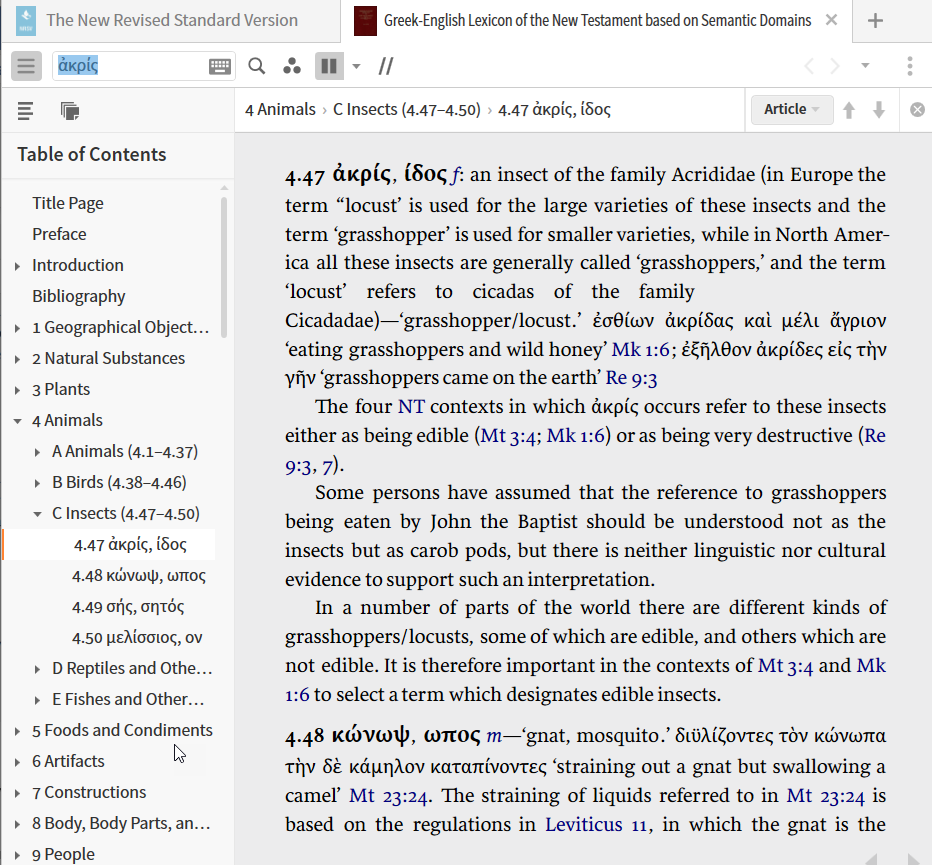Docx files for personal book: Verbum 9 part 1; Verbum 9 part 2; Verbum 9 part 3; How to use the Verbum Lectionary and Missal; Verbum 8 tips 1-30; Verbum 8 tips 31-49
Please be generous with your additional details, corrections, suggestions, and other feedback. This is being built in a .docx file for a PBB which will be shared periodically.
Previous post: Verbum Tip 5t Next post: Verbum Tip 5v
Pop-up and gutter line

When one is hovering over “locust” to open the Context Menu, there are two features to observe:
- A pop-up preview for locust is shown.
- A gutter line with some basic linguistic data is shown in the lower left. It contains:
- The lemma
- The morphology in words rather than code
- Strong’s number
- Louw-Nida number
Root
For the root there are no links at all although searches are supported.

Morph
For the morphology as well, there are no links at all although searches are supported. To add to the mystery, although the morph codes are translated three times:
- Gutter line in the lower left
- Next to the morph code on the tag side of the Context Menu
- In the heading on the right side of the Context Menu when morph is selected

In order to determine the system if morphology coding that is used:
- On the tag side, select morph
- On the action side, select Copy reference: search
- Paste from clipboard.
- <LogosMorphGr ~ NAPF>
Match the morphology system indicated by the datatype name to your resources as follows:
- Logos morphology:
- Heiser, Michael S., and Vincent M. Setterholm. Glossary of Morpho-Syntactic Database Terminology. Lexham Press, 2013; 2013.
- Heiser, Michael S., and H. H. Hardy II. Glossary of the Morphological Terms in the Aramaic Inscriptions. Lexham Press, 2008.
- BHS/BHt:
Setterholm, Vincent M. Biblia Hebraica Transcripta Glossary. Bellingham, WA: Lexham Press, 2016.
Andersen-Forbes:
Andersen, Francis I., and A. Dean Forbes. A Systematic Glossary to the Andersen-Forbes Analysis of the Hebrew Bible. Logos Bible Software, 2006.
Andersen, Francis I., and A. Dean Forbes. Biblical Hebrew Grammar Visualized. Edited by M. O’Connor, Cynthia L. Miller-Naudé, and Jacobus A. Naudé. Linguistic Studies in Ancient West Semitic. Winona Lake, IN: Eisenbrauns, 2012.
SEDRA 3 none use
Kiraz, George A. Analytical Lexicon of the Syriac New Testament: Based on the SEDRA 3 Database of George Anton Kiraz. Bellingham, WA: Logos Bible Software, 2003.
Note that this list is woefully incomplete It will be fleshed out for the Morphology Search..
Strong’s number
If you don’t already use the Strong’s number, I suggest that you ignore it. It is a late 19th century tool keyed to the King James Version for those with limited proficiency in the original languages. It essentially replaces lemma with numbers. It is superseded by computer assisted tools.
Verbum Strong numbers offer up to five lexicons in the Look up section; they all contain a Strong’s index.

The lexicons are:
Swanson, James. Dictionary of Biblical Languages with Semantic Domains: Greek (New Testament). Oak Harbor: Logos Research Systems, Inc., 1997.
Thomas, Robert L. New American Standard Hebrew-Aramaic and Greek Dictionaries : Updated Edition. Anaheim: Foundation Publications, Inc., 1998.
Strong, James. Enhanced Strong’s Lexicon. Woodside Bible Fellowship, 1995.
Vine, W. E., Merrill F. Unger, and William White Jr. Vine’s Complete Expository Dictionary of Old and New Testament Words. Nashville, TN: T. Nelson, 1996.
Strong, James. The New Strong’s Dictionary of Hebrew and Greek Words. Nashville: Thomas Nelson, 1996.
To illustrate the presence of the Strong’s index:

Louw-Nida
The Louw-Nida number is the key into a semantic domain approach to lexicons. If you are unfamiliar with semantic domains, please read this SIL article: What is a semantic domain? | Semantic Domains (semdom.org). Look up provides a single link – the link to Louw-Nida that defines the system of categorization and provides the lexicon categorized by the system.

Look up provides a link to:
Louw, Johannes P., and Eugene Albert Nida. Greek-English Lexicon of the New Testament: Based on Semantic Domains. New York: United Bible Societies, 1996.
A sample entry for locust shows the hierarchical organization on the left and the definition on the right. Note it is an actual definition not just a gloss.
